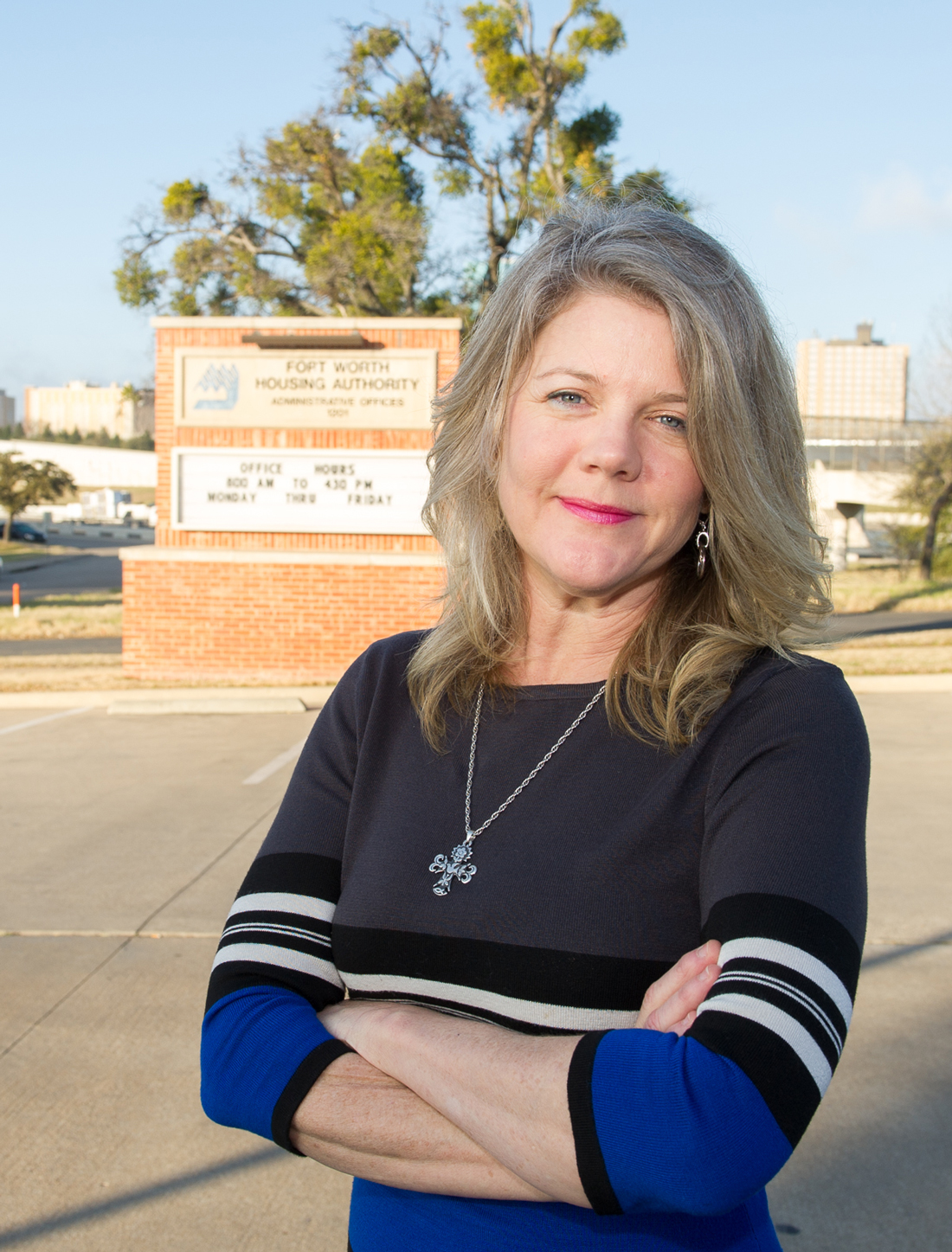The facts on homelessness in and around Tarrant County aren’t encouraging: The total number of homeless people rose by 13 percent in the last two years. Owners of homes and businesses near the Lancaster Avenue corridor are growing more vocal in their opposition to the expansion of homeless-service agencies there. And all this in the sixth year of Fort Worth’s 10-year plan to end homelessness in the city proper.
But Cindy Crain and the Tarrant County Homeless Coalition haven’t given up. Speaking to a packed audience in the Salvation Army’s Maybee Center on Lancaster recently, the coalition director outlined an ambitious program — a two-year plan to end chronic homelessness in this area.
The proposal’s scope goes beyond the city’s homeless housing program, called Directions Home. Crain said part of the coalition’s funding comes from the city, but most of it comes through the U.S. Department of Housing and Urban Development and other federal grants. Her directives also come from state and federal agencies.
The intent is not to duplicate what Directions Home is doing: The coalition plan will focus on other areas, such as job placement and managing outreach teams. If it works — much of the funding is based on performance — the plan could bring several million dollars in grants to Fort Worth.
Crain said the coalition’s plan is realistic, especially with funds for additional housing for the chronically homeless. The plan also includes creation of new job-placement programs, use of existing entitlement programs to raise the income of homeless persons, and other initiatives. The coalition is the federally designated coordinator of homeless strategies for Tarrant and Parker counties.
The Obama administration’s initiative known as Open Doors provides the outline for the Tarrant coalition’s plan. Its aim, according to the website of the U.S. Interagency Council on Homelessness, is to end veterans’ and chronic homelessness by the end of 2015 and homelessness among children, family, and youth by 2020.
The federal initiative lists only general guidelines, leaving individual agencies to draw up specifics. Crain said the Tarrant/Parker coalition is focused on finding supportive housing and federal entitlements for the disabled homeless and creating a new website to match homeless workers with jobs.
“We have over 1,500 permanent supportive housing beds where clients pay 30 percent of their income,” Crain said. “Right now 41 percent [of the Tarrant coalition’s] beds are dedicated to chronically homeless. We want this to increase to 85 percent.” The goal, she said, is to move at least 140 chronically homeless people a year off East Lancaster and into supportive housing. “That’s going to be a big policy change that starts now.”
To accomplish that, Crain said, residents of those supportive housing units who are now holding jobs can be moved into the category of units called affordable housing, with fewer services.
Increasing income for homeless people is a major goal for Open Doors, but that’s not always easy, especially for those with disabilities.
“Texas opted out of the Medicaid expansion,” Crain said. “That results in fewer funds to deal with. We also live in a state that is very strict with [food stamps].”
Another source for income is the Social Security Administration’s supplemental program for people with disabilities. Historically, getting approved for those payments has been extremely difficult.
“If these people are not getting their $600 a month, then they are stuck,” Crain said. “Over 35 percent of our homeless have disabilities, and we’ve seen a 60 percent increase in the disabled population.”
Job placement will be another priority. Crain said that 75 percent of those who stay at local shelters are capable of working. Part of the problem is convincing local businesses to hire them.
“They need jobs, but how do you get them to the top of the list of applicants?” she said.
To address that problem, the coalition is developing a “web-based pilot project that introduces employment-ready homeless to potential employers,” Crain said. “It’s like LinkedIn combined with Match.com. We believe it will reduce the stigma of homelessness.”
Local businesses are already talking to Crain about hiring homeless employees, but no formal agreements have been made, she said.
Much of the coalition’s future funding hinges on the success of the two-year plan. The Healthy Community Collaboration grant, from the Texas Department of State Health Services, could provide funds to MHMR of Tarrant County for 150 units of permanent housing, an increase of 9 percent. Crain is working closely with MHMR, assisting with the lengthy application process.
That and other grants are “based on outcomes, like reducing the homeless population,” she said.
“That’s a good start, but we really need 1,000 new beds if we are going to fix this problem,” said Flora Brewer, owner of Lancaster Lofts, a residential building in the heart of the homeless agency area.
Brewer said the city needs to reallocate several million dollars per year to house the city’s chronically homeless and disabled, in areas away from Lancaster Avenue, allowing the shelters to focus on rehabilitating those who can return to work.
“That comes out to about $8 a person per year for each of Fort Worth’s residents,” she said. “We’ve been housing the homeless for years now. We’ve developed the expertise. I’ve seen how this can change people’s lives.”
Crain said the increase in the homeless population is part of North Texas’ overall growth.
“Some parts of the country have seen an uptick in the [homeless populations] and that includes here,” she said. “This area is thriving economically, and we’re seeing people move here from the North.”
“Many of these people are opportunists,” said Mike Phipps, code enforcement chairman of the nearby West Meadowbrook Neighborhood Association, meaning that they come to Lancaster Avenue for free meals and other services when they could support themselves if they had to.
Phipps is one of many local residents who are frustrated with a string of promises that never seem to be fulfilled.
“The city’s not even following its own plan,” he said “The shelters were supposed to be distributed around the city, not just in one area.” The concentration of agencies and their clients “is putting a roadblock on development here,” he said.
Crain doesn’t blame neighborhoods for being concerned but said that her group is working to reduce the problem.
“Permanent housing could mean these folks going back with family or a bus ticket home,” she said.
Crain said there have been some notable victories the past few years, including efforts to take care of veterans and coordination among MHMR of Tarrant County, the John Peter Smith public hospital system, and police. Between 2007 and 2010, she said, Tarrant and Parker counties recorded an 18 percent decrease in the homeless population.
“One thing the city did well was using local police to get rid of people who were preying on the homeless,” she said. She’d like to see the city double its funding for a Directions Home program managed by MHMR called tenant-based support services.
According to Catherine Carlton, communications director at MHMR, the services group provides “[mental health] assessments, peer support, group support, and in-home life skills training.
“We target formerly homeless people and help them remain in the home,” she said.
Fort Worth City Council member Kelly Allen Gray, whose district includes the Lancaster homeless agencies, was one of the speakers at the plan’s unveiling. She said she supports Crain’s new initiative, the goals of which are similar to those of Directions Home.
When asked if she is optimistic about the prospects of her program, Crain paused.
“Yes, if we approach this as a community [and] receive up to 150 new beds through the Healthy Community Collaboration grant,” she said. “The momentum of that could be dramatic.”













This is a joke all the shelters do is promote homelessness so they can stay in business. They get people hooked on the social services, so they are only one step from homelessness. Then when something happens they are right back so the shelters get more money. UGM is the worst of all of them. They have no programs, except healing shepherd clinic, for the homeless. They send people to other agencies for help. These shelters need to be put under a microscope so the public can see what really goes on in them.